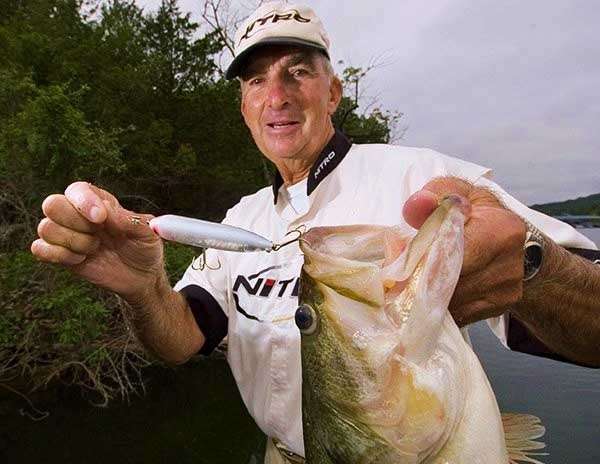
Years ago, I authored a series for Bassmaster Magazine titled “Techniques Illustrated,” the concept of which was simple: Feature top pros with their best techniques in a concise format, and support it with illustrations.
One of the pros I featured was none other than Charlie Campbell, one of the all-time greats of topwater fishing. Part of what earned him that acclaim was his ability to walk a surface lure around emergent objects, like boulders, stumps, standing timber and dock pilings — and when I say “around” them, I mean nearly circling the object.
He was the absolute best at it.
When I heard of this unique ability, I had to see it for myself. So I asked, and as cordial and friendly as Charlie is, he took the time to show me.
His lure of choice was a full-size, Original Heddon Zara Spook. He said its smooth, tubular body and weighted tail section was the key to making the lure glide from side to side. That, combined with the right balance of tackle and a worthy target, was all that was needed … except for a little practice, of course.
Making It Happen
Charlie preferred a medium action, 5 1/2-foot baitcasting outfit spooled with 14-pound mono — claiming the lighter line helps the lure glide better. For added mobility, he attached a No. 3 interlocking snap to the lure’s line tie, which also helps in what he referred to as the “side-stepping” motion.
To begin, Charlie would cast slightly to the side and beyond the target, then begin his patented half-step cadence. To achieve this, he would remove any slack line, and with the rod tip down, begin short, rhythmic pulls using only his wrist. The cadence consists of one strong pull with a slightly delayed, second half pull — alternating these throughout the retrieve.
To maximize the lure’s glide in one direction, each half pull is executed on slack line. The length of each pull, along with the cadence, will determine the distance the lure will travel. Charlie recommended pulls of 6 to 8 inches.

As you twitch the lure, line is recovered with each snap of the wrist. Though this may sound a bit complicated, turning the reel handle comes quite naturally as you twitch the rod. The key is not to think about it too much.
According to Charlie, you could almost do this better blindfolded. Watching the lure can cause your cadence to become erratic. Instead, he suggests concentrating on twitching the rod tip. As the gliding lure forms slack in the line, you’ll feel it, and that’s when you twitch again.
How the fish responded determined how quickly or aggressively he would retrieve the lure. A quick and positive response would allow for a hotter retrieve speed, while lazy, lethargic responses would usually require slowing or even pausing the retrieve.
Where & Why
Since learning the technique, I’ve found it useful on a number of occasions. The best targets are usually hard objects with relatively smooth surfaces, such as those mentioned previously. Once you get the hang of it, it’s fairly easy to make the lure walk around these types of objects.
For me, the Rapala SkitterWalk is easier to force in one direction — probably because it pivots better. And that’s true even for the smaller size, which would otherwise be much too difficult for the technique.

Whatever your preference, the important thing is to get the lure walking in the right direction quickly, so that it begins wrapping the line around the backside of the target. Once the lure reaches the object, its repeated contact will attract fish.
Essentially, you’re “bumping the stump.”
Visualize some small creature clawing at an object, as if it were struggling to climb out of the water. Fish never see that type of action from a topwater lure — at least not around hard objects — so that in itself makes it appealing. Plus it’s fun!
So thanks Charlie, for helping to improve my topwater skills so long ago. Not only have I caught some nice fish using your technique, I’ve also bankrolled a few bucks along the way.





